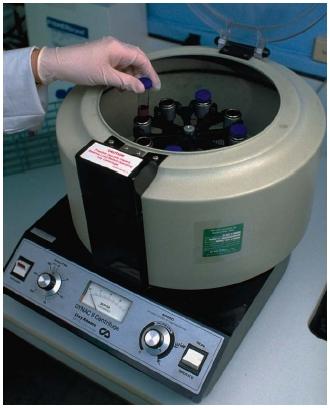Separating mixtures
· In order to separate mixtures you need to devise a process that separates components with different properties.
· Some of these properties include:
o High density/ Low density
o Volatile/ Non volatile
o Soluble/ Insoluble
o Magnetic/ Non magnetic
o Polar/ Non polar
· The more similar the properties = the more difficult it is to separate them.
Some Basic Techniques
Hand Separation and Evaporation
· Hand separation (solids and solids)
o This is the most basic technique.
o Magnets or sieves may also be used to separate mechanical or heterogeneous mixtures.
o Ex. A dry mixture of salt and sand. *Note – manually picking out the sand does not change the chemical identity of the salt or the sand.
· Evaporation (solid dissolved in a liquid solution)
o Boil away the liquid and the solid remains.
Example of Evaporation· Filtration (solids(not dissolved) and liquids)
o Selects components by particle size. Liquid and gaseous components will pass through the filter while the solid particles will be retained.
o Can use a porous filter or filter paper (residue left in filter paper, filtrate goes through filter paper)
Watch this youtube video on filtration!http://www.youtube.com/watch?v=Q0s71cjCNWs
· Crystallization
o A change happens to a mixture (either physical or chemical)
o Solids are then separated by filtration or floatation. Remaining solid comes out as pure crystals and they are then filtered from the remaining solvent.
Youtube Time! http://www.youtube.com/watch?v=Jd9C40Svt5g&feature=related
· Gravity Separation (solids based on density)
o A centrifuge whirls a test tube around at high speeds forcing the denser materials to the bottom.
o Works best for small volumes
Centrifuge· Solvent Extraction
o A technique also called liquid extraction, used to separate liquids.
o Separation of a substance from a mixture by dissolving that substance in a suitable solvent
o Works best with solvents that only dissolve one component
o Mechanical mixture: (solid and solid) use liquid to dissolve one solid but not the other so the desired solid is left behind or dissolved.
o Solution: solvent is insoluble with solvent already present. Solvent dissolves one or more substances and leaves unwanted substances behind.
· Distillation
o (liquid in liquid)
o Based on differences in volatilities in a boiling liquid mixture
o Physical separation process. Not chemical.
o The liquid with the lowest boiling temperature boils first- vapour ascents to distillation flask and enters condenser; gas cools and condenses back to liquid dropping the distillate as a purified liquid.
Process of Distillation· Chromatography
o Can separate very complex mixtures
o Accurate and very precise
o Separated components can be collected individually
o Flow the mixture over a material that retains some components more than others, so different components flow over the material at different speeds
o A mobile phase sweeps the sample over a stationary phase
· Sheet Chromatography
o Paper Chromatography (PC)
§ Stationary phase= a liquid soaked into a sheet or strip of paper
§ Mobile phase = a liquid solvent
§ Components appear as separate spots spread out on the paper after drying or “developing”
Youtube Time!http://www.youtube.com/watch?v=fLc36wxLrVI
o Thin layer Chromatography (TLC)
§ Stationary phase = a thin layer of absorbent coating a sheet of plastic or glass
§ Some components bond to the absorbent strongly; others weakly
§ As with paper chromatography components appear as spots on the sheet
By Candace





No comments:
Post a Comment